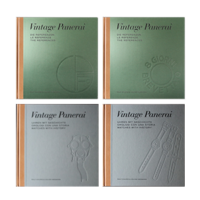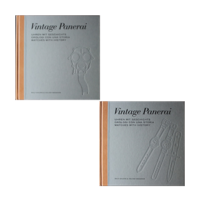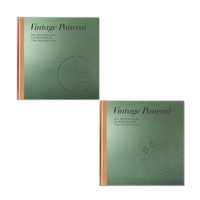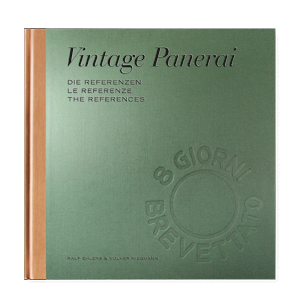Phillips WINNING ICONS featuring a 3646 and a 6152/1
by Volker on Oct.03, 2017, under Allgemein
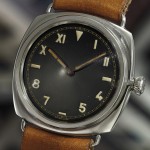 Two Vintage Panerai watches will be up for auction in the WINNING ICONS auction at Phillips on 26 October 2017 in New York. Inbetween a total of 50 watches in the auction with the subtitle “Legendary Watches of the 20th Century”, Lot 16 is a 3646 / Type E with “California Dial” (photo), followed by Lot 39, a Ref. 6152/1 with 8 mm Rolex crown and “Marina Militare” dial. Find further info on both watches in our Watch Point.
Two Vintage Panerai watches will be up for auction in the WINNING ICONS auction at Phillips on 26 October 2017 in New York. Inbetween a total of 50 watches in the auction with the subtitle “Legendary Watches of the 20th Century”, Lot 16 is a 3646 / Type E with “California Dial” (photo), followed by Lot 39, a Ref. 6152/1 with 8 mm Rolex crown and “Marina Militare” dial. Find further info on both watches in our Watch Point.
[Photo with kindly permission / courtesy of www.phillips.com]
Two “Watches with History” @ Phillips GWA6
by Volker on Sep.26, 2017, under Allgemein
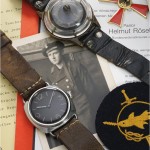 Phillips will auction two Vintage Panerai watches on Sunday, 12 November 2017 during their Geneva Watch Auction: SIX. Lot 209 is a Ref. 6152/1 “Luminor Panerai” and Lot 210 is a Ref. 3646 / Type C “Kampfschwimmer” (photo).
Phillips will auction two Vintage Panerai watches on Sunday, 12 November 2017 during their Geneva Watch Auction: SIX. Lot 209 is a Ref. 6152/1 “Luminor Panerai” and Lot 210 is a Ref. 3646 / Type C “Kampfschwimmer” (photo).
Read more on both “Watches with History” in our Watch Point. Lot 209 is featured in our book “The References” 1950’s-1960’s – more info here. Lot 210 is featured in our book “History2” – more info here.
[Photo with kindly permission / courtesy of www.phillips.com]
#solderedlugsunday
by Volker on Aug.13, 2017, under Allgemein
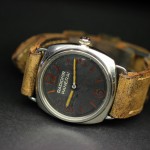 More than two hundred watches of the Reference 3646 are registered in our database today. Among all different Vintage Panerai models, the 3646 marks the reference with the most known specimen in our records. In 2009, eight years ago, 143 recorded watches were featured in the first (sold out) edition of our book “The References”. Within the entire serial number sequence of the reference 3646, we differentiate between seven different variations (3646 / Type A – Type G). The photo on the left shows a Ref. 3646 / Type C with “Radiomir Panerai” dial, which is featured in chapter II.III (page 306-321).
More than two hundred watches of the Reference 3646 are registered in our database today. Among all different Vintage Panerai models, the 3646 marks the reference with the most known specimen in our records. In 2009, eight years ago, 143 recorded watches were featured in the first (sold out) edition of our book “The References”. Within the entire serial number sequence of the reference 3646, we differentiate between seven different variations (3646 / Type A – Type G). The photo on the left shows a Ref. 3646 / Type C with “Radiomir Panerai” dial, which is featured in chapter II.III (page 306-321).
In our book “The References” 1930’s-1940’s the watches of the entire reference 3646 are featured in chapter II with more than six hundred pages in the chapters II.I-II.VII following an intro on page 40-49. The seven different variations can be found in our reference quickfinder on page 14-20.
Chapter II.I = Reference 3646 / Type A
(featuring two different watches on page 50-169).
Chapter II.II = Reference 3646 / Type B
(featuring four different watches on page 170-247).
Chapter II.III = Reference 3646 / Type C
(featuring seven different watches on page 248-397).
Chapter II.IV = Reference 3646 / Type D
(featuring nine different watches on page 398-531).
Chapter II.V = Reference 3646 / Type E
(featuring four different watches on page 532-573).
Chapter II.VI = Reference 3646 / Type F
(featuring two different watches on page 574-607).
Chapter II.VII = Reference 3646 / Type G
(featuring two different watches on page 608-645).
See the different inner casebacks of Ref. 3646 / Type A – Type C watches here, as well as the inner casebacks of Ref. 3646 / Type D – Type G watches here. Enjoy reading!
Our “The Reference” books are available in our bookstore.
Found: another Ref. 3646 / Type D “Kampfschwimmer”
by Volker on Jun.29, 2017, under Allgemein
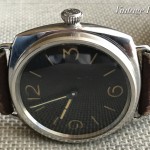 Introducing another piece of the puzzle – and one more surfaced in Germany: a Ref. 3646 / Type D with anonymous sandwich dial and rare “Kampfschwimmer” engraving with initials of the first owner and year of service (1945) on its outer caseback. The watch is accompanied with matching paperwork of the first owner, dating back to 1944, as well as a small compass.
Introducing another piece of the puzzle – and one more surfaced in Germany: a Ref. 3646 / Type D with anonymous sandwich dial and rare “Kampfschwimmer” engraving with initials of the first owner and year of service (1945) on its outer caseback. The watch is accompanied with matching paperwork of the first owner, dating back to 1944, as well as a small compass.
The watch has been added into our database in early May 2017 and appears with high bezel (a typical feature of the watches with sandwich dials), onion shaped “Brevet +” crown (Type 11) and Rolex Cal. 618 / Type 1 movement. The watch has never been polished and still has its original “volcano dome” plexi as well as the original leather strap and large, nickel-plated brass pin buckle. The blued steel hands still hold their complete luminous material. The inner caseback is signed with the Rolex SA hallmark, reference and case number.
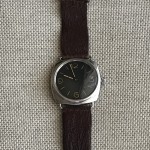 Watches of the Reference 3646 / Type D are featured in our book “The References” 1930’s-1940’s in chapter II.IV (page 398-531). Small compasses are featured in chapter IV (where a similar version is shown on page 672-675). Chapter V holds information on straps and buckles (page 679-685 featuring the “bottle opener” shaped pin buckles).
Watches of the Reference 3646 / Type D are featured in our book “The References” 1930’s-1940’s in chapter II.IV (page 398-531). Small compasses are featured in chapter IV (where a similar version is shown on page 672-675). Chapter V holds information on straps and buckles (page 679-685 featuring the “bottle opener” shaped pin buckles).
Thanks to the owner who provided information for our database.
[Ralf Ehlers & Volker Wiegmann]
2007 – ten years ago…
by Volker on Jun.10, 2017, under Allgemein
…we started our first book project in summer 2007 – “Vintage Panerai – Watches with History”. Research on watches and the hunt for historic documents, photos and information begun. For the documentation of Mario Arillo’s Ref. 6152/1 “Luminor Panerai” we got several copies of historic photos from its second owner, of which one b&w copy of a photo (far left in the photo below) caught our special attention.
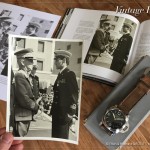 The caption under the photo told “Festa di Marina, 10 giugno 1943. Il comandante Mario Arillo, qui con i gradi del capitano di corvetta, riceve dal Re d’Italia, Vittorio Emanuele III, la Medaglia d’Oro al Valore Militare. Decorazione concessa dopo il forzamento del Porto di Algeri della notte del 12 dicembre 1942 da parte di mezzi d’assalto, che erano stati trasportati in prossimà dell’obiettivo dal sommergibile Ambra.”
The caption under the photo told “Festa di Marina, 10 giugno 1943. Il comandante Mario Arillo, qui con i gradi del capitano di corvetta, riceve dal Re d’Italia, Vittorio Emanuele III, la Medaglia d’Oro al Valore Militare. Decorazione concessa dopo il forzamento del Porto di Algeri della notte del 12 dicembre 1942 da parte di mezzi d’assalto, che erano stati trasportati in prossimà dell’obiettivo dal sommergibile Ambra.”
With the support of Fabio Castellani, the second owner of the watch, we were able to send a letter directly to the family of Mario Arillo (1912-2000), asking for the original photo to make a scan of it for using it in the book and to return it back immedately. A few weeks later, a letter from the family arrived in the author’s mailbox …including the original photo from 1943! After the scan was done with great care, the photo returned to the family, as promised. But to the surprise of the authors, the photo hit their mailbox once again only a few days after it was sent back to La Spezia. This time with a dedication on the backside, handwritten by the commander’s daughter, and with the wish to keep it with us. Memories from ten years ago – this happened in June 2007.
A few months later, in October 2007, our first book was published, the photo found a prominent place on page 130. This sold out book with 228 pages “Vintage Panerai – Watches with History” was replaced five years later, in 2012, by the book “History1” in which we published extended information on 420 pages. With the support of Arillo’s family we were able to document his story in chapter IV on a total of 165 pages and with more than 100 historical photos and illustrations, some of them never published before. The photo found its place on page 344 once again. In 2016, Arillo’s Ref. 6152/1 has been featured in chapter VIII.II of our book “The References” (page 942-955). A short intro about its first owner is opening with the very photo on page 950. It was taken on 10 June 1943, exactly 74 years ago today…
New in our database: A Ref. 3646 / Type B “Radiomir Panerai”
by Volker on May.24, 2017, under Allgemein
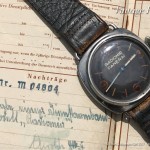 Another Ref. 3646 / Type B watch with “Radiomir Panerai” sandwich dial has been added into our database. The actual owner of the watch provided us further information on the first owner with the very rare ID of the german frogman Robert E., dating back to the last months of the Second World War.
Another Ref. 3646 / Type B watch with “Radiomir Panerai” sandwich dial has been added into our database. The actual owner of the watch provided us further information on the first owner with the very rare ID of the german frogman Robert E., dating back to the last months of the Second World War.
The watch appears with its original leather strap and nickel-plated brass pin buckle. The inner caseback bears the typical Rolex hallmark, case and reference number, known in watches of the Ref. 3646 / Type B as well as the Rolex Cal. 618 / Type 1 movement. The initial Rolex screw-down crown has been replaced with the crown mounted on the watch, shown in the actual photos.
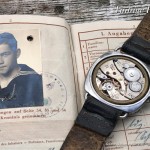 At the age of 17, Robert E. posted to the Kommando der Kleinkampfverbände in February 1945. He took part at a special training course for frogmen and divers, held at a small Danish Island (see page 203 of our book “History1”) documented in his ID by the stamp “Kampfschwimmer- und Tauchlehrgang”.
At the age of 17, Robert E. posted to the Kommando der Kleinkampfverbände in February 1945. He took part at a special training course for frogmen and divers, held at a small Danish Island (see page 203 of our book “History1”) documented in his ID by the stamp “Kampfschwimmer- und Tauchlehrgang”.
Another signature in his ID is showing a stamp of the Kampfschwimmergruppe Ost (eastern combat swimmer group), to which he was posted after the training, dating back to April 1945.
A very interesting supplementary note can be found in his ID, hand written below the field post number: Ausgabe einer Dienstarmbanduhr Modell “Radiomir” confirming that a diving watch was issued to him for duty, even more mentioning the particular model being a “Radiomir”.
Rare documentation, such as an ID of a frogman, providing interesting information about which ways these watches took many years ago. Thanks to the owner for providing the additional info aside the details of the watch, being a new entry in our Vintage Panerai database!
“Trittico”
by Volker on May.03, 2017, under Allgemein
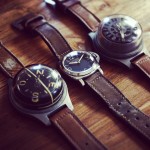 Compass, watch and depth gauge made by Guido Panerai & Figlio: a “Trittico”. Huge and impressive instruments worn on the wrist. Compasses, watches of the Ref. 6152/1 and depth gauges are featured in several versions (with “Radiomir” and “Luminor” luminous material) in the chapters VIII.II, XI.I and XI.II of the second volume of our book “The References”.
Compass, watch and depth gauge made by Guido Panerai & Figlio: a “Trittico”. Huge and impressive instruments worn on the wrist. Compasses, watches of the Ref. 6152/1 and depth gauges are featured in several versions (with “Radiomir” and “Luminor” luminous material) in the chapters VIII.II, XI.I and XI.II of the second volume of our book “The References”.
Chapter VIII.II is about the watches of the Ref. 6152/1 with crown-protecting device and Rolex movement and holds information about nine different models (page 922 to 1057) with “Marina Militare”, “Radiomir Panerai” and “Luminor Panerai” dials (as shown in the photo). Chapter XI.I is about compasses from Guido Panerai & Figlio. Five different models are featured from page 1320 to 1333. Three with “Radiomir”, two with “Luminor” dials. Chapter XI.II is featuring depth gauges. Ten different models are featured from page 1334 to 1367. Six with “Radiomir” dials, aimed to 7, 30, 35 (2 versions: adjustable and non-adjustable dial), 50 and 60 meters. Four with “Luminor” dials, aimed to 7, 15, 16, 30 and 40 meters. Last but not least, chapter XII gives an overview of the straps and buckles used on watches and instruments from Guido Panerai & Figlio in this era.
Information on “The References” 1950’s-1960’s can be found here.
Arrivederci, Isidoro Mario Nardin
by Volker on Apr.26, 2017, under Allgemein
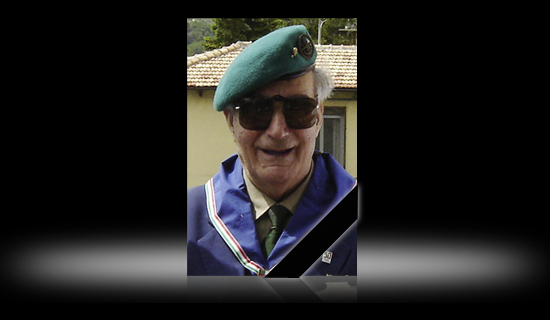 Sad news from Italy reached us today: Isidoro Mario Nardin, WW2 veteran of the “Gruppo Gamma”, passed away earlier this year, 27 February 2017, at the age of 94. We send our belated condolences to his family.
Sad news from Italy reached us today: Isidoro Mario Nardin, WW2 veteran of the “Gruppo Gamma”, passed away earlier this year, 27 February 2017, at the age of 94. We send our belated condolences to his family.
We first met Isidoro Mario Nardin in person back in 2006 when he was proudly showing his watch to us. Eight years later, and with the valueble support of Paolo Ferraro, the son of Luigi Ferraro M.O.V.M., it was possible to contact Isidoro Mario Nardin (the third owner of the Ref. 3646 / Type C which initially belonged to Licio Visintini M.O.V.M.) to be able to present the watch in detail in chapter II.III of our book “The References”.
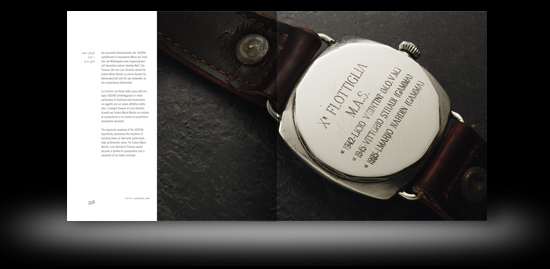
Beside many photos of the watch with the engraved caseback bearing the three names of its owners (see above page 358-359), a historic photo from 1946 showing Isidoro Mario Nardin in full diving gear, is closing the chapter on watches of the Ref. 3646 / Type C (see below page 396-397).
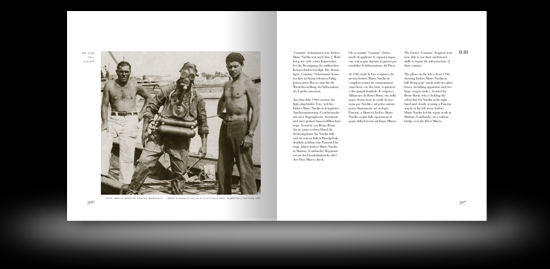
“Arrivederci!” Sig. Nardin, rest in peace!
[Ralf Ehlers & Volker Wiegmann]
One more engraved Ref. 3646 / Type B with “Radiomir Panerai” dial surfaced
by Volker on Mar.20, 2017, under Allgemein
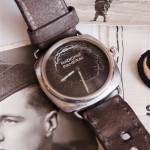 You never know how long it takes until a “new”, yet unknown watch surface after many years. This happened quickly twice in the last weeks, with another addition into our database in shape of a Ref. 3646 / Type B with “Radiomir Panerai” sandwich dial and completely engraved “Kampfschwimmer” caseback.
You never know how long it takes until a “new”, yet unknown watch surface after many years. This happened quickly twice in the last weeks, with another addition into our database in shape of a Ref. 3646 / Type B with “Radiomir Panerai” sandwich dial and completely engraved “Kampfschwimmer” caseback.
Different to the Ref. 3646 / Type C with riveted plastic dial introduced earlier here (which included a month-lasting research for the family of the frogman), this rare Ref. 3646 / Type B “Radiomir Panerai” watch was introduced to us by the grandson of the frogman. Complete with the original strap and nickel-plated brass buckle, the watch with the small Oyster Watch Co hallmark on its inner caseback appears after 72 years with the original domed plexiglas, onion shaped “Brevet +” crown (Type 11) and Rolex Cal. 618 / Type 1 movement.
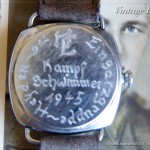 The caseback of the watch bears the initials “HE” of the first owner. The frogman belonged to the “Einsatzgruppe Heyden” which is engraved around the word “Kampfschwimmer” and the year of service, 1945. Lieutenant-Commander Günter Heyden was a founding member of the newly formed German commando frogmen (Kommando Spezialkräfte Marine) in the 1950’s.
The caseback of the watch bears the initials “HE” of the first owner. The frogman belonged to the “Einsatzgruppe Heyden” which is engraved around the word “Kampfschwimmer” and the year of service, 1945. Lieutenant-Commander Günter Heyden was a founding member of the newly formed German commando frogmen (Kommando Spezialkräfte Marine) in the 1950’s.
The watch is accompanied with historic photos of the veteran as well as a very rare pay book (silmiar to only two others known which are made of the same material, see page 138 in our book “History1”) and which was issued to the members of the “Lehrkommando 700″ in the last months of the Second World War. Not enough rarity, there is a swordfish probation insignia (see page 802-804 in our book “History2”) and a nose clip which was used by the frogmen during the use of a small breathing apparatus (without face mask, see page 671 of our book “The References” 1930’s-1940’s and page 718 of our book “History2”).
Watches of the Ref. 3646 / Type B are featured in our book “The References” (first volume / 1930’s-1940’s) in chapter II.II on page 170-247.
Surfaced after 72 years: one more Ref. 3646 / Type C with riveted plastic dial
by Volker on Mar.19, 2017, under Allgemein
When we started to search for the veteran at the beginning of 2017, we could not know wether the search would be successful or not (like many times before). We knew the frogman only by his name, featured in battlefield reports since the mid 1950’s several times, and we knew the city in Germany where he lived after the end of the Second World War.
When we virtually knocked at his door, nobody was there to open anymore. With a big portion of luck and the cooperation of his family, we connected a few months later to finally ask his family some questions, which the veteran himself was sadly not able to answer anymore. We provided some photos of the German “Kampfschwimmer” from 1944 and 1945 to the family, which they had never seen before, but which were part of our records since several years.
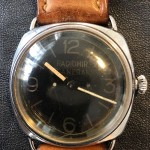 Recently we got photos of the Vintage Panerai watch, which the frogman stored in a safe place before the war was over and before he became a POW of the British. Before we saw the first photos, our “wild guess” was, that it could be a Ref. 3646 / Type D. But the soon later arrived photos of the dial let us think it might be an earlier version: a 3646 with riveted plastic dial. Maybe it would be a Ref. 3646 / Type B like most of the watches with such dials are recorded? The final proof to which number group it belongs to, was the look onto the inner caseback of the watch: a Ref. 3646 / Type C with Rolex SA hallmark in the center and a seven digit number underneath the reference number 3646. So, one more piece of the Vintage Panerai puzzle added in shape of a Ref. 3646 / Type C with riveted plastic dial.
Recently we got photos of the Vintage Panerai watch, which the frogman stored in a safe place before the war was over and before he became a POW of the British. Before we saw the first photos, our “wild guess” was, that it could be a Ref. 3646 / Type D. But the soon later arrived photos of the dial let us think it might be an earlier version: a 3646 with riveted plastic dial. Maybe it would be a Ref. 3646 / Type B like most of the watches with such dials are recorded? The final proof to which number group it belongs to, was the look onto the inner caseback of the watch: a Ref. 3646 / Type C with Rolex SA hallmark in the center and a seven digit number underneath the reference number 3646. So, one more piece of the Vintage Panerai puzzle added in shape of a Ref. 3646 / Type C with riveted plastic dial.
The remarkable “untouched” condition, since it was keepsake for the veteran and has remained in the possession of the frogman’s family during all these years (72 years, to be exactly), can be pointed out by the fact that the watch has still the original leather strap sewn onto the soldered lugs of the cushion shaped case and the nickel-plated brass buckle (in the typical “bottle opener” shape with sharp edges) as well as a Rolex 618 / Type 1 movement with details known in more than 90% of all recorded watches of the Ref. 3646 / Type C in our database. The still complete luminous material on the blued steel hands can be rarely found on watches of this age, as well as the original domed plexi and the onion shaped crown (“Brevet +” / Type 11). More about watches of the Ref. 3646 / Type C can be found in our book “The References” 1930’s-1940’s on page 248-397 in chapter II.III.
We hope that the watch remains as a keepsake for the family and maybe the veteran’s grandchildren enjoy wearing it in the future. [Ralf Ehlers & Volker Wiegmann]

